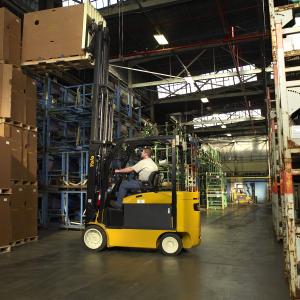
While many of the safety concerns presented in a warehouse environment involve the use of forklifts or other heavy machinery, there are also a number of safety issues associated with the way in which materials are stored. Whether stacked incorrectly, in a less than ideal location, or without regard to OSHA guidelines, there are a number of factors that can compromise the safety of your warehouse environment.
Jump to Sections:
As one of the leading suppliers of storage rack systems and shelving in the industry, LiftOne has a depth of knowledge and experience when it comes to pallet racking and warehouse safety. Below you’ll find a variety of tips and best practices for safe storage and pallet stacking in and around the warehouse.
Potential Warehouse Stacking Hazards & Solutions
When materials are stacked too high or placed in unstable configurations, removing pallets or items from the stack, or even accidentally bumping it, can result in an unpredictable and potentially dangerous tumble. The warehouse stacking methods below can be used to ensure stability and reduce the risk of falling objects in your warehouse:
- Irregular Stacking – For improved stability, add sheets of plywood between each layer of irregularly shaped items.
- Brick Stacking – Turn each level of a stack 90 degrees to increase stability.
- Block Stacking – Stack square items in a cube and make sure to secure them with wire or plastic shrink wrap.
- Pinwheel Stacking – Turn each quadrant of items 90 degrees. This helps to “lock” everything in place.
Guidance From OSHA
Thanks to OSHA guidelines, warehouse managers everywhere have an accessible and detailed manual to help increase warehouse safety and improve safe storage in very concrete and deliverable ways. A few of the key elements that comprise OSHA safe stacking guidelines include the following material handling safety precautions:
- Stack loads as straight and evenly a possible.
- Place heavier loads on lower shelves.
- Keep storage areas free from accumulation of materials that could lead to tripping, fire, explosion, or pest infestations.
- Ensure that personnel use proper lifting techniques.
- Store bags, containers, bundles, etc. in tiers that are stacked, blocked, interlocked, and limited in height. This helps keep materials stable and secure, while preventing them from sliding or collapsing.
- Maintain appropriately marked and sufficiently safe clearances for aisles and at loading docks or passageways where mechanical handling equipment is used.
Pallet-Specific Safety
With pallets an integral part of warehouses everywhere, staying on top of pallet-specific safety measures and best pallet racking practices is key to continued warehouse safety. A general guideline to pallet safety includes remembering to systematically inspect pallet conditions, specifically looking for damaged stringers, broken pieces, or protruding nails. Pallets that show signs of damage or wear should be removed from use. You’ll also want to remember not to exceed load capacities, as well as ensure the size of your pallets is compatible with the safety standards of your material handling equipment.
For more tips on safe storage or information about how to improve warehouse safety, get in contact with the experts at LiftOne today.










